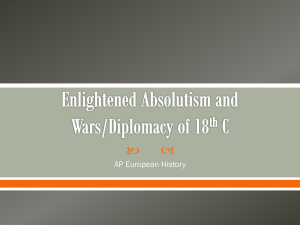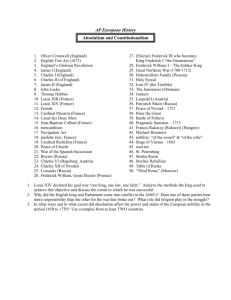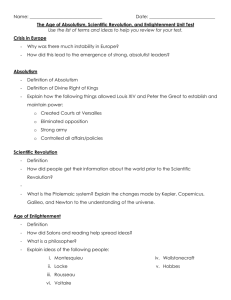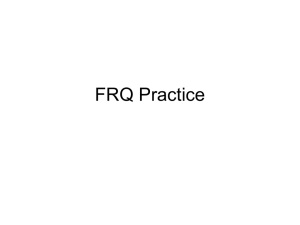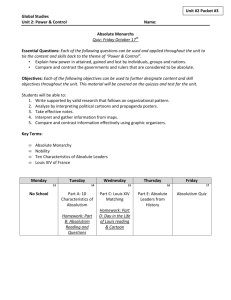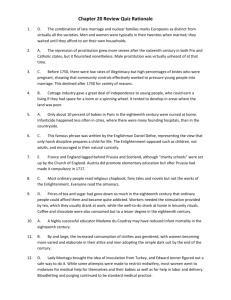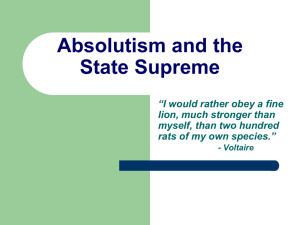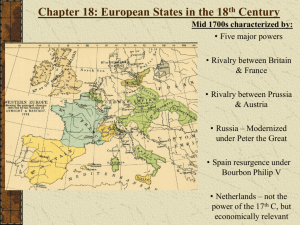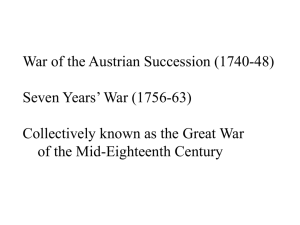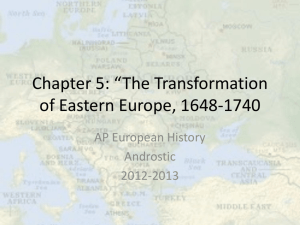chapter outline
advertisement
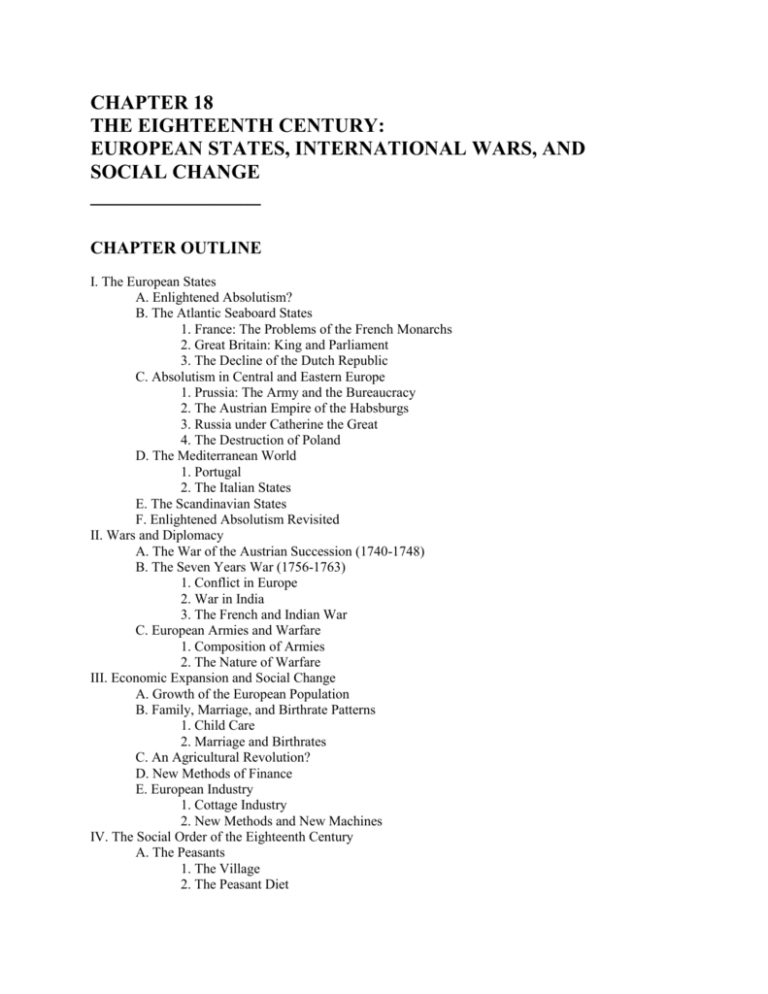
CHAPTER 18 THE EIGHTEENTH CENTURY: EUROPEAN STATES, INTERNATIONAL WARS, AND SOCIAL CHANGE _________________ CHAPTER OUTLINE I. The European States A. Enlightened Absolutism? B. The Atlantic Seaboard States 1. France: The Problems of the French Monarchs 2. Great Britain: King and Parliament 3. The Decline of the Dutch Republic C. Absolutism in Central and Eastern Europe 1. Prussia: The Army and the Bureaucracy 2. The Austrian Empire of the Habsburgs 3. Russia under Catherine the Great 4. The Destruction of Poland D. The Mediterranean World 1. Portugal 2. The Italian States E. The Scandinavian States F. Enlightened Absolutism Revisited II. Wars and Diplomacy A. The War of the Austrian Succession (1740-1748) B. The Seven Years War (1756-1763) 1. Conflict in Europe 2. War in India 3. The French and Indian War C. European Armies and Warfare 1. Composition of Armies 2. The Nature of Warfare III. Economic Expansion and Social Change A. Growth of the European Population B. Family, Marriage, and Birthrate Patterns 1. Child Care 2. Marriage and Birthrates C. An Agricultural Revolution? D. New Methods of Finance E. European Industry 1. Cottage Industry 2. New Methods and New Machines IV. The Social Order of the Eighteenth Century A. The Peasants 1. The Village 2. The Peasant Diet B. The Nobility 1. The Aristocratic Way of Life: The Country House 2. The Aristocratic Way of Life: The Grand Tour C. The Inhabitants of Towns and Cities 1. The Problem of Poverty V. Conclusion CHAPTER SUMMARY During the eighteenth century, royal authority was often justified by the service the monarch could render to the state and its people rather than by divine right. Some believed that the monarchs should have a monopoly of power in what is called “enlightened despotism” or “enlightened absolutism.” Britain’s constitutional monarchy was an alternative. For much of the century France was ruled by Louis XV (r.1715-1774). Only five when he ascended the throne, in his maturity he proved to be weak and lazy, controlled by his mistresses and advisors. His successor was little better. Louis XVI (r.1774-1793) was unprepared, and his wife, Marie Antoinette, an Austrian princess, became a focus of anti-royal attitudes. In Britain, power was shared between kings and parliament, with the latter gaining influence. The new ruling dynasty, from Hanover in Germany, was ignorant of British traditions and incompetent, which led to a new position in government, that of the Prime Minister. Trade and manufacturing were beginning to supercede the economic power of land and agriculture. Prussia rose to major power status under Frederick William I (r.1713-1740) and Frederick II the Great (r.1740-1786), strengthening the kingdom through an efficient bureaucracy and a larger army. Frederick the Great was in the model of an enlightened despot: he reformed the laws, allowed religious toleration and considerable freedom of speech and the press, but he also increased the army to 200,000. In the Austrian Empire, Empress Maria Theresa (r.1740-1780) centralized the government and Joseph II (r.1780-1790) abolished serfdom, reformed the laws, and granted religious toleration, but his reforms did not outlast his reign. Russia’s Catherine II the Great (r.1762-1796) also instituted reforms, but they favored the landed nobility rather than the peasants and serfs. Russia gained territory at the expense of the Ottoman Empire and Poland, and the latter disappeared from the maps, partitioned among Prussia, Russia, and Austria. In Italy, Austria replaced declining Spain as the paramount power. War was endemic, with national interests and dynastic concerns prevailing in a system guided by the balance of power. The mid-century War of the Austrian Succession (1740-1748) and the Seven Years War (1756-1763) were fought not only in Europe but also in North America and India. Frederick the Great was the instigator, desiring Austrian Silesia, but Britain was the true victor, driving France from Canada and India, and creating a world-wide empire. Standing armies were the norm, and with religious passions more muted, wars were less ideological. The population grew, mainly as the result of a declining death rate and improvements in agriculture thanks to a warmer climate, better livestock, improved soil fertility, and new crops such as the potato. Paper money or banknotes compensated for the dearth of gold and silver, and institutions such as the Bank of England mobilized the wealth of the kingdom through credit and loans. The seeds of the industrial revolution were planted, notably in the textile industry where new technologies transformed the manufacture of cotton cloth. The patriarchal family remained the core of society. Late marriages limited the birthrate, but there was considerable illegitimacy. 85 percent of the population were peasants, freer in the west than the east, but still facing many legal obligations. The nobility were 2 or 3 percent. Their large country estates defined their life style, but anyone with sufficient wealth could generally enter their ranks. The Grand Tour also defined aristocratic life: sons of the elite traveled widely in search of culture and education. Townspeople were a small minority except in Britain and the Dutch Republic; London had a population of 1 million, Paris half that. Urban mortality rates were high and poverty widespread, with prostitution and begging the means of survival for many. SUGGESTED LECTURE TOPICS 1. Enlightened Absolutism: Myth and Reality 2. Catherine the Great and Frederick the Great: What Constitutes Greatness? 3. The Social, Political, and Cultural Role of the Nobility in the Eighteenth Century 4. European Imperialism and Colonialism in the Eighteenth Century 5. European Dynastic Military Conflicts and the Geopolitics of Global War
